Converge: Disciplinarities and Digital Scholarship encourages design educators, design researchers, and designers to take advantage of opportunities in digital scholarship, learn how to collaborate on interdisciplinary projects, and find new intersections within their existing research trajectories. To redefine what it means to be a designer and a design researcher today, we ask: How can design converge with digital scholarship in more than a superficial way? How might aspects of digital scholarship impact design research? What are the key questions at the intersection of design and the humanities?
This conference took place June 1-3, 2017 in Los Angeles, CA.
Keynote Speakers
Johanna Drucker
Breslauer Professor of Bibliographical Studies, Department of Information Studies, UCLA
Casey Reas
Professor, UCLA Design Media Arts, and Co-Founder, Processing
Erik Loyer
Creative Director, The Alliance for Networking Visual Culture
Conference Location
School of Cinematic Arts (SCA)
University of Southern California
900 West 34th Street
Los Angeles, CA 90089-2211
Connect
converge.aiga.org
converge.aiga@gmail.com
facebook.com/groups/AIGAConverge
twitter.com/aiga_converge
#aigaconverge
Organizing Committee
Jessica Barness
Associate Professor, School of Visual Communication Design, Kent State University
Her research resides at the intersection of design, humanistic inquiry, and interactive systems, investigated through a critical, practice-based approach. She has presented and exhibited her work internationally, and has published research in Design and Culture, Dialectic, Visual Communication, and Message, among others. She recently co-edited a special issue of the journal Visible Language with Amy Papaelias entitled “Critical Making: Design and the Digital Humanities” (2015).
Vicki Callahan
Associate Professor, School of Cinematic Arts, at the University of Southern California.
Her research and teaching is focused on the integration of theory and practice with attention to issues in film and media history, feminist studies, digital culture, media strategies for social change, and public scholarship. She was an NEH fellow for the inaugural workshop, “Scholarship in Sound and Image,” on Videographic Criticism at Middlebury College, and in 2015 she was in residence at University College Cork, Ireland as a Fulbright Scholar with a focus on digital media praxis.
Heather Corcoran
Director, College and Graduate School of Art; Professor, Design, Washington University in St. Louis
Her work explores relationships between information and expression in collaborative projects for social impact and self-generated projects for exhibition. She was lead author on the article “Making cancer surveillance data more accessible for the public through Dataspark,” published in Visible Language in 2013, and co-principal investigator on a grant funded by the National Cancer Institute (NIH), 2009-11. An exhibition of her work, Reading Time: Visual Timelines, Texts, and Canons, opened at Gallery 360 at Northeastern University in Boston in 2014.
Sarah Lowe
Professor, Graphic Design, University of Tennessee
Her work across technology, cultural heritage and museum studies researching the design of digital engagement with the public has led to research partnerships with The National Park Service, The US Holocaust Museum, and the Eastern Band of the Cherokee Nation. Her work has been presented at CUMULUS, NORDES and the Museum Computer Network (MCN) in addition to several DEC conferences. In 2012/13 she was a Fulbright Scholar at the University of Oslo, Norway, researching the design of educational technologies in relation to learning theory.
Amy Papaelias
Assistant Professor, Graphic Design, SUNY New Paltz
She has presented her design research and pedagogy at Theorizing the Web, the Type Directors Club, NYC DH Week, TypeCon, and other DEC conferences. In 2013, Amy participated in One Week One Tool, an NEH-funded Institute for Advanced Topics in the Digital Humanities. She co-edited a special issue of the journal Visible Language with Jessica Barness entitled “Critical Making: Design and the Digital Humanities” (2015). She is a founding member of Alphabettes.org.
Holly Willis
Chair, Media Arts + Practice, School of Cinematic Arts, University of Southern California
Former DEC Steering Committee co-chair, Holly works at the intersection of cinema, design, media literacy and the humanities. She co-founded and launched the practice-based Media Arts + Practice program integrating design research and critical theory/making, and is currently involved with USC’s Mellon-funded Digital Humanities Program supporting humanists in manifesting their research through media-rich experiences. She has helped organize and has presented at many previous DEC conferences, including New Contexts/New Practices, Schools of Thought III and NEXT
SPONSORS
USC School of Cinematic Arts
Washington University in St. Louis
Kent State University: College of Communication and Information, School of Information, School of Visual Communication and Design
Browse the Converge: Disciplinarities and Digital Scholarship Collections
The “General Contractor” of Academia? How a Meta- and Systems- Oriented Perspective May Position Designers as Facilitators of Cross-Disciplinary Academic Collaborations
06/03/2017Brad Tober, Boston University
While design researchers continue working to carve out their individual roles within the larger university context, institutions increasingly demand the forging of productive, cross-disciplinary collaborations of all sorts. To those academics unfamiliar with the work of their design researcher colleagues, a joint endeavor might present itself as an appealing opportunity to obtain professional / commercial design work in service of an otherwise design-irrelevant project. There are also instances of large science / engineering grant solicitations (such as the National Science Foundation’s 2013 Emerging Frontiers in Research and Innovation program investigating engineering applications of origami folding techniques) requiring a creative researcher to participate as part of the investigative team behind a given proposal—although, with little to no direction as to the specific role that individual should assume.
Of course, there are bound to be anecdotal accounts of designers’ successful cross-disciplinary collaborations, and while there are various models of collaborative design, there does not appear to be a generally accepted model of design-inclusive cross-disciplinary collaboration in academia. In response, this paper discusses the foundation leading toward such a model for a particular definition of the design researcher—one which reflects the shifting role of professional practitioners from that of merely executing processes in which the objective is producing finalized creative output to engaging directly with the development of tools and frameworks facilitating the creative processes of others. This concept of meta-design is itself a response to the increasing democratization of design, but it very much relies on designers’ communicative aptitude and diverse skill sets to, in the context of academic collaborations, effectively coordinate the members of a team. Indeed, while meta-designers can still bring design-specific knowledge to such a cross-disciplinary collaboration, the added value they bring in this model is the ability to fully leverage the unique contributions that each team member can provide as part of the collective effort. This recognizes that a cross-disciplinary academic collaboration is actually a designed system (with its individual components unable to function alone) and, in fact, very closely reflects the way specialized designers approach professional practice.
This paper will, in particular, discuss a case study of a cross-disciplinary academic collaboration that occurred over approximately four years, culminating in late 2015, at a major American research university. Assembling librarians, curators, computer scientists, publishers, designers, and others, the team engaged in this digital humanities-focused effort could not have been more diverse. As a design researcher, the author was initially tasked with the design of a publishing platform highlighting a series of rare book facsimiles and other associated media, but later transitioned out of that role (one that focused on “producing finalized creative output”) and consulted on larger issues related to design strategy; a design professional specifically handling visual / aesthetic concerns later joined the team. The author’s knowledge and ability to facilitate intra-team communication was critical throughout the course of the project, ultimately enabling a greater level of understanding among collaborators regarding the viability of various project directions.
Brad Tober is a designer, educator, and researcher whose work investigates the potential relationships of emerging code-based and interactive visual communication technologies to both design practice and pedagogy. His practice-led research is characterized by a speculative approach to design that recognizes that forms of and methodologies for contemporary practice that spans design and technology are best developed through flexible and exploratory processes. Prior to his current position as Assistant Professor of Design + Visual Analytics at Boston University, Brad spent five years as Assistant Professor of Graphic Design at the University of Illinois at Urbana-Champaign. Brad holds an MDes from York University (Canada), a BFA in graphic design from the Savannah College of Art and Design, and a BA in mathematics from the University at Buffalo.
This was a Long Paper Session: On Collaboration on June 3, 2017. 11:30am–1:00pm (SCI 106)
Students designing understanding: Design + Code + French = Play
06/03/2017Cary Staples, University of Tennessee
As opposed to creating a product that teaches; the focus of the “APP Farm” is to create a workshop that allows students to seek and acquire information by solving the problems inherent in creating a product. “On the surface, the union of the humanities and video games might seem odd, the former focused on thoughtful reflection, context and contingencies, and the latter on reflex, immediacy and instantaneous feedback. In practice, however, this union is increasingly proving to be an enormously profound one, with games providing a platform for more experiential ways of engaging history, literature, philosophy, and even religion.” (Humanities Arcade, 2016) Based on the critically acclaimed analog game series by Brenda Romero, “The Mechanic is the Message“, “[Romero] suggests that games are capable of a higher form of communication, one which actively engages the participant and makes them a part of the experience rather than a passive observer.” Games are particularly powerful teaching and learning tools. Instead of giving information to students, games pose questions that James Paul Gee (2007) would call “pleasantly frustrating” so that the player is invested in finding the answer. Games also have the ability to provide the player with information “just in time” to allow the player to accomplish the quest.
Deborah Smith-Shank (2014) suggests that the current teaching dynamic “…assumes that there is a correct body of knowledge for a teacher to communicate to students. These models assume a hierarchical architecture of facts and ideas with higher forms of knowing built through some concatenation of simpler forms. In order to move away from the dominant hierarchical model, it is necessary to develop an entirely different framework.” The notion of “student as receiver of information” needs to evolve to “student as author of understanding.” To empower such learning, we have developed a working design studio. Using French culture + language acquisition as the subject matter and employing cross-functional teams including Graphic Design, French, Computer Science, Music and Education, students and faculty collaborate to facilitate the design and development of an app. Students were challenged to design materials to help peers understand course content in a meaningful way. The goal of the studio is to allow students to experience STEM learning and humanities learning through the lens of design.
Cary Staples is a designer. period.
She is also an educator, a creative problem solver, a math geek, an origami explorer and a game developer. With 25 years of professional design experience, her newest project is The App Farm. The App Farm endeavors to frame problems so that cross-functional teams can come together, each from a specific area of strength, to collaborate and create innovative learning landscapes and experiences.This was a Long Paper Session: Student-led Labs on June 3, 2017. 9:00–10:30am (SCI 106)
Shared Futures: Practices and Methods of Speculative Design, World Building, Design Fiction and Participatory Design
06/03/2017
Joshua McVeigh-Schultz (panel chair), University of Southern California
Emilia Yang, University of Southern California
Biayna Bogosian, University of Southern California
Laura Cechanowicz, University of Southern California
Karl Baumann, University of Southern California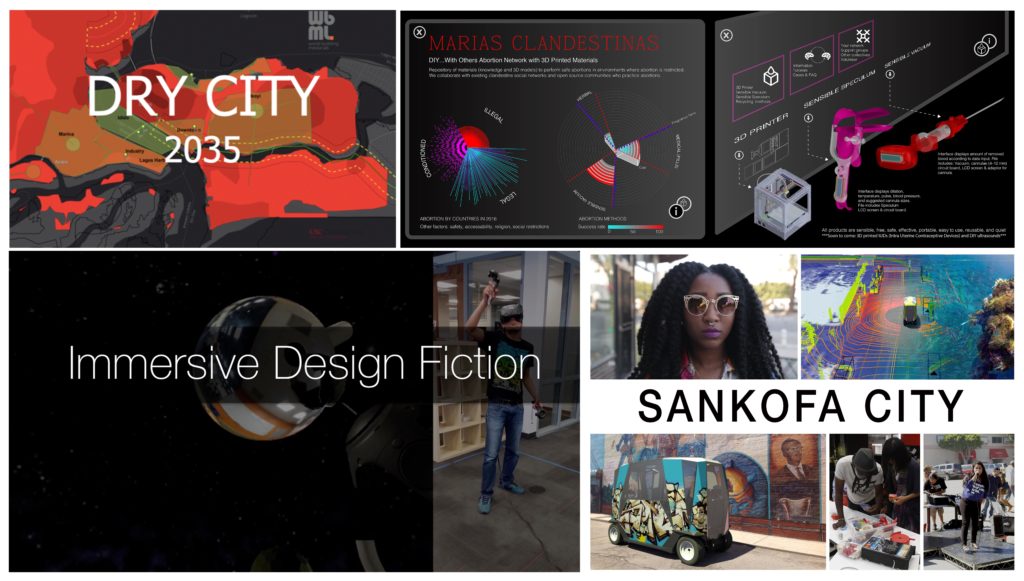
This panel aims to expand the speculative design framework in order to dialogue with and incorporate humanistic methods of research and pedagogy. We argue that the future-facing formation of provocative designs – densely packed with cultural information – provide profound potentials for pedagogy and the production of knowledge. At their core, all of the projects explore temporality and spatiality in order to provoke novel design insights, critique the present, and envision alternative potential futures.
Collectively, the panel members’ interdisciplinary work represents the evolving role of critical future-facing design practices within academic scholarship and teaching. The panel will explore their digital scholarship methods that infrastructure the imaginative (and often collective) work and make it accessible to wider publics. The projects represent a range of formal outputs including 3D printing, AR/VR, video, and Scalar.
The structure of this panel is developed strategically to create dialogue between reflective methodologies and specific projects. Our methods collectively propose pedagogical models of creative participation and speculative imagining. While Sankofa City and Worldbuilding, Autobiographical Identity + Pedagogy both work with participants throughout all the stages of the design process, Marías Clandestinas uses speculative design with the aim of developing open-source participatory fabrication methods, and Immersive Design Fiction creates interactive experiences that productively integrate speculative and experiential approaches to design.
Each of these panel presentations will situate design practices in relation to concerns of digital scholarship, critically engaged research, and design as pedagogy. Central to these concerns is a basic reforming of the concept of pedagogy around design thinking processes, digital tools, and community/public participation. Our assumption is that design reformulates pedagogy by empowering students and communities/publics in the learning process, destabilizing the hierarchies of pedagogy to place participants on more equal footing. In this way, pedagogy is not merely a dissemination of knowledge as much as it is a co-creation of design and meaning. These talks position the speculative design process as a form of creative scholarly inquiry. Designed objects and experiences serve as provocations that critique the present or offer alternative visions of our collective future. Moreover, by empowering participants and incorporating cognitive and cultural diversity into the design process, design teams can develop news ways of addressing “wicked problems” and exploring unknowable futures.
Panelists and Papers
Paper 1
Marías Clandestinas: between control, speculation and fabrication for a DIWO (Do-it-with-Others) abortion kits
Emilia Yang and Biayna Bogosian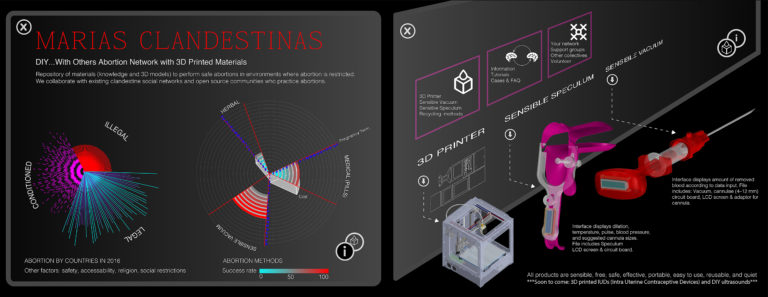
In this intervention, we highlight the struggles between new technologies and the ever-changing control of the female body. We introduce our project, Marias Clandestinas, a DIWO-bio (Do-it-with-Others biotechnology) speculative design project which responds to the rise of the DIY abortions, with an active online support network, and several open-source mass-customized tools. We focus on the concept of DIWO as a project development model which enables like-minded people to collaboratively work on tasks, projects, or activist causes. DIWO also inherits a grassroots type of community formation away from formal structures and institutions. In our DIWO-bio project, we describe our separate practices, and how we approached collaboration touching upon the traditions of participatory culture, tactical media, biopolitics, tactical biopolitics, citizen’s science, and speculative and critical design’s wide spectrums that are in conversation with our project.
Paper 2
Worldbuilding, Autobiographical Identity + Pedagogy: Digital scholarship in the design process
Laura Cechanowicz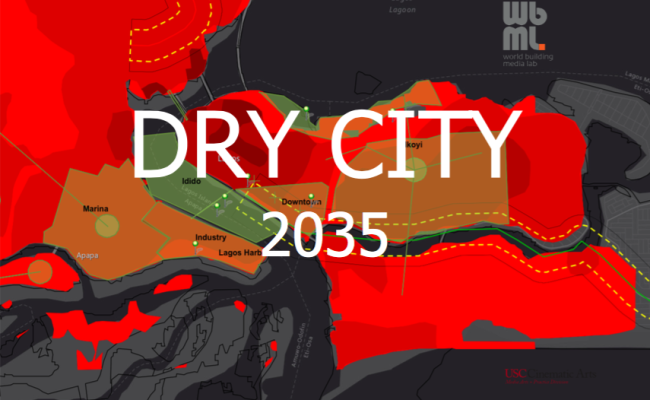
This panelist will focus on experience teaching across three semesters in the USC Worldbuilding Course, as well as on her dissertation focused on mobility disability and autobiographical identity. These projects contextualize digital media tools for collaborative design. Through worldbuilding, the creation of knowledge is a collaborative and holistic experience of design, and digital tools provide us with structures for sharing research and knowledge across the team. Not only this, the final outputs of the design process can include publications of digital research documents, in addition to conventional transmedia outputs: artifacts, films, VR experiences, etc. These processes also reflect a modified approach to pedagogy, since worldbuilding as design methodology strives to engage participants, students, teachers, and community members on an equal level. The discussion will further include research into design as applied to autobiographical identity.Paper 3
Immersive Design Fiction: Prototyping Speculative Sociotechnical Practices
Joshua McVeigh-Schultz (Chair), working with Keshav Prasad and Max Kreminski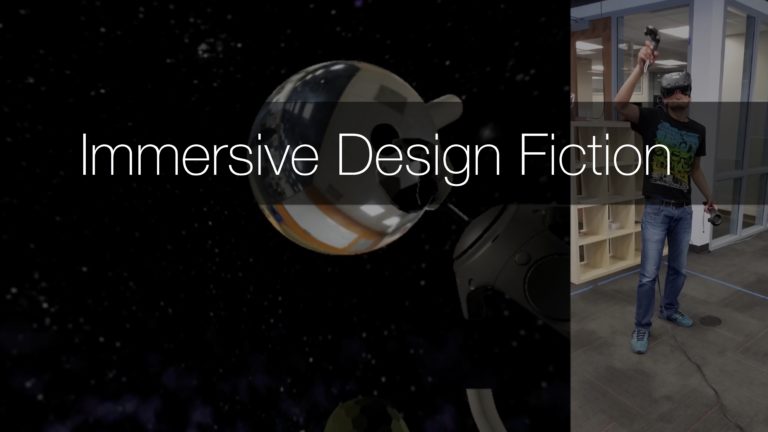
Techniques such as speculative design and design fiction offer important reminders that any story we tell about a new technology is also a story about the broader social practices that we imagine growing up around it. However, these sorts of approaches traditionally leave much of the actual experience of a speculative technology up to the imagination of a user or viewer. This gap between what can be imagined and what can be experienced is a significant one, but one that design researchers can overcome by leveraging emerging tools of immersive design. In particular, richly immersive technologies, such as room-scale VR, offer design researchers new tools for exploring speculative interfaces within an experiential world. This talk presents a case study of a research lab’s collaborative exploration of speculative interfaces for creative work in the context of industrial design.Paper 4
Sankofa City: Speculative Community Design
Karl Baumann, working with Ben Caldwell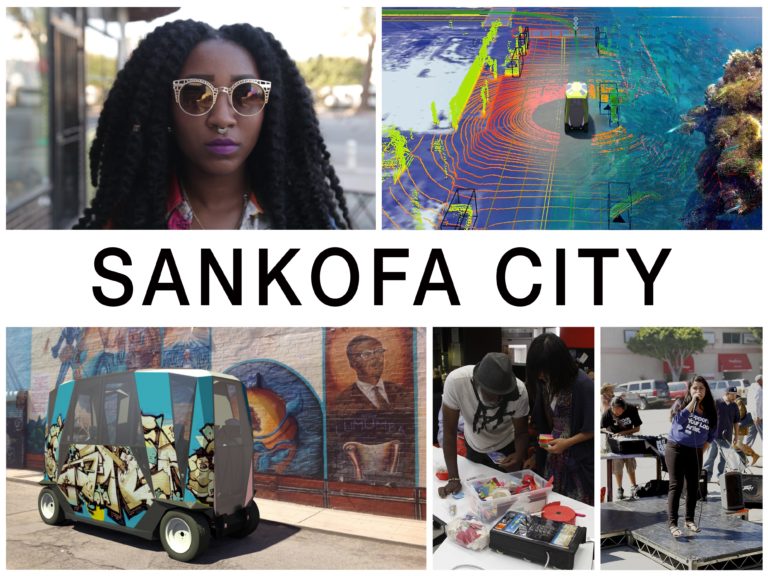
Sankofa City is a speculative participatory design project that works with local community members in South LA to envision and plan for how urban-based technologies will be incorporated in their neighborhood by 2050. In the face of “disruptive” emerging technologies and the threat of cultural displacement, the project seeks to create alternative models for local innovation, cultural preservation, and sustainable urban development. University students worked in teams with local residents and artists to create speculative design artifacts and videos to model imaginative alternative futures and spark critical public discussion. Balancing ethics with aesthetics, the combination of participatory and speculative processes create a provocative public-facing series of co-designs that are rooted in local cultural practices and their desires for the future.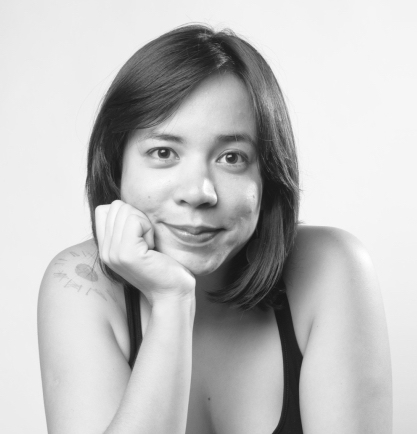 Emilia Yang is an activist, artist, and militant researcher. Her work has been interconnected with digital media, performance, and public art. Yang is currently pursuing a PhD in Media Arts + Practice at the School of Cinematic Arts at the University of Southern California, Los Angeles. Her research focuses on participatory culture and its relationship to media, arts, and design. She is interested in how transmedia storytelling and postcolonial new media practices can foster social change and civic engagement. Her art practice utilizes site-specific interactive installations, documentaries, fictions, games, performance, and urban interventions to engage participants in political action and discussion.
Emilia Yang is an activist, artist, and militant researcher. Her work has been interconnected with digital media, performance, and public art. Yang is currently pursuing a PhD in Media Arts + Practice at the School of Cinematic Arts at the University of Southern California, Los Angeles. Her research focuses on participatory culture and its relationship to media, arts, and design. She is interested in how transmedia storytelling and postcolonial new media practices can foster social change and civic engagement. Her art practice utilizes site-specific interactive installations, documentaries, fictions, games, performance, and urban interventions to engage participants in political action and discussion.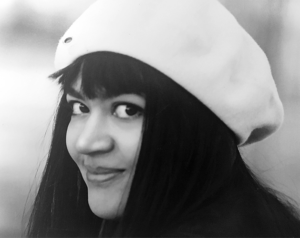 Biayna Bogosian is an architect and interactive media designer researching perceptual and cognitive interaction design that highlight the relationship between urban and environmental data patterns. Biayna is pursuing a Ph.D. in Media Arts & Practice in the School of Cinematic Arts at the University of Southern California. She holds a Master of Science in Advanced Architectural Design from Columbia University, and a Bachelors of Architecture from Woodbury University. Since 2011, Biayna has taught digital media and architectural design courses at Columbia University Graduate School of Architecture Planning and Preservation and USC School of Architecture. Biayna is principal of Los Angeles-based studio Somewhere Something that works at the intersection of architecture, urban design, interaction design, and digital fabrication, in order to change the way we perceive and construct our cities.
Biayna Bogosian is an architect and interactive media designer researching perceptual and cognitive interaction design that highlight the relationship between urban and environmental data patterns. Biayna is pursuing a Ph.D. in Media Arts & Practice in the School of Cinematic Arts at the University of Southern California. She holds a Master of Science in Advanced Architectural Design from Columbia University, and a Bachelors of Architecture from Woodbury University. Since 2011, Biayna has taught digital media and architectural design courses at Columbia University Graduate School of Architecture Planning and Preservation and USC School of Architecture. Biayna is principal of Los Angeles-based studio Somewhere Something that works at the intersection of architecture, urban design, interaction design, and digital fabrication, in order to change the way we perceive and construct our cities. Joshua McVeigh-Schultz is an interactive designer and media artist who recently earned a PhD in the Media Arts and Practice from USC’s School of Cinematic Arts. His research focuses on the intersection between speculative design and ritual, and his current work leverages VR to envision the future of industrial design (through a partnership with Steelcase’s Futures of Work group). He was awarded an Intel PhD Fellowship for his dissertation on speculative rituals of liveness. He has conducted research in USC’s Mobile & Environmental Media Lab, Intel Labs’ Interaction Experience Research Group and Microsoft Research’s Social Media Collective. He also earned an MFA from UC Santa Cruz in Digital Arts & New Media and an MA in Asian Studies from UC Berkeley.
Joshua McVeigh-Schultz is an interactive designer and media artist who recently earned a PhD in the Media Arts and Practice from USC’s School of Cinematic Arts. His research focuses on the intersection between speculative design and ritual, and his current work leverages VR to envision the future of industrial design (through a partnership with Steelcase’s Futures of Work group). He was awarded an Intel PhD Fellowship for his dissertation on speculative rituals of liveness. He has conducted research in USC’s Mobile & Environmental Media Lab, Intel Labs’ Interaction Experience Research Group and Microsoft Research’s Social Media Collective. He also earned an MFA from UC Santa Cruz in Digital Arts & New Media and an MA in Asian Studies from UC Berkeley.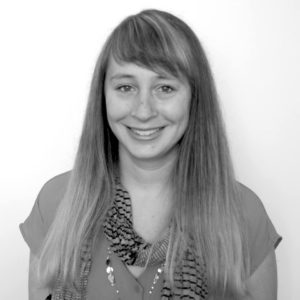 Laura Cechanowicz is Los Angeles based designer and worldbuilder, working with research and theory. She works across mediums, including animation, film and VR, production design, and sound design. Thematically and formally her work explores embodiment and memory through identity and neuroscience, the intersections of art and science, and the ways people record and transcribe personal histories. Laura’s theory and practice research focuses on the human body. Her passion is participatory art as social practice, and she views teaching as an integral part of this work. Laura earned her BA from the University of Michigan with Film & Video, Psychology and German majors, her MA in Film Studies from the University of Iowa, and her MFA in Animation from USC. An Annenberg Fellow, her production design talent was recognized at the 2015 Berlinale, and her work in world building design exhibited at the 2016 Venice Biennale. She is a USC iMAP PhD student and a member of the USC World Building Institute.
Laura Cechanowicz is Los Angeles based designer and worldbuilder, working with research and theory. She works across mediums, including animation, film and VR, production design, and sound design. Thematically and formally her work explores embodiment and memory through identity and neuroscience, the intersections of art and science, and the ways people record and transcribe personal histories. Laura’s theory and practice research focuses on the human body. Her passion is participatory art as social practice, and she views teaching as an integral part of this work. Laura earned her BA from the University of Michigan with Film & Video, Psychology and German majors, her MA in Film Studies from the University of Iowa, and her MFA in Animation from USC. An Annenberg Fellow, her production design talent was recognized at the 2015 Berlinale, and her work in world building design exhibited at the 2016 Venice Biennale. She is a USC iMAP PhD student and a member of the USC World Building Institute.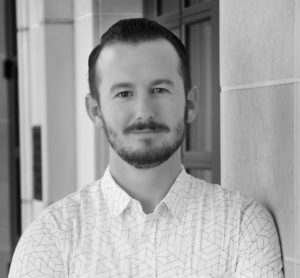 Karl Baumann is a designer, filmmaker, and researcher. His current work lies at the intersection of speculative design and community art. Working across cinema, games, and mobile media, his methodology is based on collaborative design and user participation that explores the future of civic engagement, urbanism, and networked technology. Karl holds an M.F.A. in Digital Arts and New Media (DANM) from UC Santa Cruz. He is currently an Annenberg Fellow in the Media Arts + Practice (MAP) Ph. D. program at the University of Southern California. Karl works with the World Building Media Lab (WBML), the Mobile and Environmental Media Lab (MEML), the Media, Activism, and Participatory Politics (MAPP) project, and the Annenberg Innovation Lab (AIL). He is also working with Intel’s Global Production Lab and the Google News Lab’s R&D group.
Karl Baumann is a designer, filmmaker, and researcher. His current work lies at the intersection of speculative design and community art. Working across cinema, games, and mobile media, his methodology is based on collaborative design and user participation that explores the future of civic engagement, urbanism, and networked technology. Karl holds an M.F.A. in Digital Arts and New Media (DANM) from UC Santa Cruz. He is currently an Annenberg Fellow in the Media Arts + Practice (MAP) Ph. D. program at the University of Southern California. Karl works with the World Building Media Lab (WBML), the Mobile and Environmental Media Lab (MEML), the Media, Activism, and Participatory Politics (MAPP) project, and the Annenberg Innovation Lab (AIL). He is also working with Intel’s Global Production Lab and the Google News Lab’s R&D group.This was a Panel Discrussion on June 3, 2017. 1:00–2:30pm (SCI 108)
Shape Of An Absence: Designing The Black Subject And The Case For Critical Race Design Studies
06/02/2017John Jennings, University of California at Riverside.
Peter Fine, University of Wyoming
Stacey Robinson, University of Illinois
Marshall Shorts, ARTfluential and Creative Control Fest (CCF)
Intelligent Mischief, a creative action design labThere will be white mythologies, invented Orients, invented Africas, invented Americas, with a correspondingly fabricated population, countries that never were, inhabited by people who never were— Calibans and Tontos, Man Fridays and Sambos— but who attain a virtual reality through their existence in travelers’ tales, folk myth , popular and highbrow ction, colonial reports, scholarly theory, Hollywood cinema, living in the white imagination and determinedly imposed on their alarmed real-life counterparts.
— Charles W. Mills, The Racial Contract
The recent events in our country around race have been extremely revealing. From the rise of Black Lives Matter to the tragic, racially motivated church shooting in South Carolina, these tumultuous instances have acted as flash-points around a systemic issue that many Americans have chosen to ignore. Race and its associated systems of oppression are still a major issue in our society. This fact has been part of the fabric of American society since the formation of our nation. It’s a mediated and highly designed cultural phenomenon that historically has been visualized via decades of readily consumable visual culture. is denial of the pervasiveness of racism, in part, is one of the most complex visual communication problems in the history of our country. In addition, negative visual communications have been partially responsible for the messages that have inflicted a legacy of suffering and lack upon black people while their white counterparts have basked in the light of the American Dream.
Professor Mark Anthony Neal’s ground-breaking book Looking For Leroy: Illegible Black Masculinities puts forth the thesis that American society has not been taught to read the alternative identities that are performed in the African American community and that the negatively stereotypical renderings from advertisements, cartoons, television and other designed imagery have caused a societal “illiteracy” when dealing with the Black body. Black subjectivity and person hood have been stripped away and re-inscribed as “demonic”, “wild”, and “scary”. This dissonance between the real and the constructed creates a litany of questions: If the black body can be read as a “text” then, historically, what have been the consequences when that text is misinterpreted? How does one disentangle the constructed fantasies and fears of the black body from the humanity of the Black subject? How can design possibly deal with some of these difficult problems?
Racism is a system and systems are imagined, designed and executed. Graphics, designed objects, and illustrations can function as indexes for these underlying structures and can therefore, possibly, be redesigned. This is one of the main theories around a new area of study and practice called critical race design studies. This aspect of design can be defined as: an interdisciplinary design practice that intersects critical race theory, speculative design, design history, and critical making to analyze and critique the effects of visual communication, graphic objects, and their associated systemic mediations of racial identity.
Design is always a future oriented space and it can be part of the key that unlocks the answer to one of the most pervasive issues in our society. The purpose of this panel will be to examine the problems at hand regarding race as a designed object and explore case studies of how some design educators are leading the charge in reconsidering race, design and the black subject.
John Jennings (panel chair) is a Professor of Media and Cultural Studies at the University of California at Riverside. His creative and academic work centers around intersectional narratives regarding identity politics and popular media. Jennings is co-editor of the Eisner Award winning collection The Blacker the Ink: Constructions of Black Identity in Comics and Sequential Art and co-founder/organizer of The Schomburg Center’s Black Comic Book Festival in Harlem. He is co-founder and organizer of the MLK NorCal’s Black Comix Arts Festival in San Francisco and also SOL-CON: The Brown and Black Comix Expo at the Ohio State University. Jennings is currently a Nasir Jones Hip Hop Studies Fellow with the Hutchins Center at Harvard University. Jennings’ current projects include the Hiphop adventure comic Kid Code: Channel Zero, the supernatural crime noir story Blue Hand Mojo, and the New York Times best-selling graphic novel adaptation of Octavia Butler’s classic dark fantasy novel Kindred.
Peter Fine (panelist) is the author of Sustainable Graphic Design: Principles and Practice, published by Bloomsbury Academic in 2016. He is a writer, curator, teacher and producer of creative work on the subject of race and representation. This interdisciplinary practice will culminate in his next single author book for Bloomsbury, The Design of Race: How Visual Culture Shaped America to be published in 2019. He is an Assistant Professor of Art and Graphic Design at the University of Wyoming. University of Wyoming Dept. of Art and Design.
Stacey Robinson (panelist) is an Assistant Professor of graphic design at the University of Illinois is an Arthur Schomburg fellow who completed his Masters of Fine Art at the University at Bu alo. His work discusses ideas of “Black Utopias” as spaces of peace away from co- lonial in uence by considering Black a uent self-sustaining communities, Black protest movements and the art movements that document(ed) them. As part of the collaborative team “Black Kirby” with artist John Jennings, he creates graphic novels, gallery exhibitions and lectures that deconstruct the work of artist Jack Kirby to re-imagine Black resistance spaces inspired by Hip Hop, religion, the arts, and sciences. His exhibition ‘Binary ConScience’ explores ideas of W.E. B. Du Bois’s “double consciousness” as a Black cultural adaptation and a means of colonial survival. Recent works appear in books: ‘Kid Code: Channel Zero’ from Rosarium Publishing, ‘Prison Industrial Complex For Beginners,’ from For Beginners Books, and upcoming ‘The Black Speculative Arts Movement: Afrofuturism, Art+Design’ (edited by Reynaldo Anderson) from Lexington Books.
Marshall Shorts (panelist) is an award winning entrepreneur, artist and designer. Shorts is Creative-N-Chief and founder of ARTfluential; a boutique creative agency made up of a collective of artisans, designers, developers and thinkers that live at the intersection of design, technology and culture. In an effort to engage the creative industries more comprehensively, Marshall co-founded Creative Control Fest (CCF) in 2012. CCF is an annual grassroots con-fest aimed at the mutual exchange of resources with creatives of color in the industries of art, design, activism, scholarship and entrepreneurship. The conference focuses on inclusion, exposure, education and opportunities for underrepresented groups in the growing creative and tech industries.
Intelligent Mischief (panelist) is a creative action design lab using culture, narrative and design to hack social change. It’s mission is to boost invention and imagination, realign action logic and experiment with new forms of civil society to create atmospheres of change. They believe in the power of culture. These cultural experiences inform our identities, communities, & politic, and impact how they see the world. IM curates transformative designed experiences and interventions that re-imagine the possibilities and shift the “common sense”. As afro-caribbean immigrants, veteran organizers, and creatives/cultural organizers they bring a unique perspective and range of skills to their broader social justice community and social justice values and vision to the creative sphere. Intelligent Mischief works at the nexus of arts, popular culture, social change and activism. Their networks allow them national reach with deep Boston roots. They are particularly committed to working with black and brown communities to o er solutions that are often fenced o from them due to expense or lack of cultural awareness of existing design and creative firms.
This was a Panel Session on June 2, 2017. 1:30–2:30pm (SCI 106)
Real Knowledges, Virtual Designs: A Roundtable on Conducting Practice-Based Research in Virtual Reality
06/01/2017Luis Blackaller (chair), WeVR
Samantha Gorman, Tender Claws
Kate Parsons, FLOAT
Tonia Beglari, Browntourage and Downtown Browns
Adam Sulzdorf-Liszkiewicz, RUST LtdThis roundtable of scholar-practitioners will share some of the design discoveries they’ve made while exploring the expressive affordances of virtual reality, and will discuss how their artistic explorations have functioned in relation to their individual, ongoing research practices.
When working in new mediums like VR, scholars often seek to establish unifying vocabularies by beginning with general questions: What is ‘virtual reality’? What can VR do? In contrast, designers and artists often begin by making things, and thus by employing technical knowledge to better understand the creative potentials of different variations on a platform. This panel will seek to bridge the gap between scholarly and design-oriented research procedures, and will model how groups of scholar-practitioners can study subspecies of, and divergences within, different modes and contexts of media making — how they can obtain local knowledges about mobile VR, 360-degree cinema, room-scale VR, art installations, and so on, and connect these local knowledges to the ever-growing and ever-virtual realm of scholarship. In this way, the panelists hope to share their own personal vocabularies about virtual reality, with one another and the audience, in the hopes of better joining those vocabularies, sharing and comparing their insights, and drawing some real conclusions from their virtual design practices as a method of design education.
The panel will be chaired by Luis Blackaller (Creative Director, WeVR), who will discuss his design process behind VR projects at WeVR, including a recent collaboration with Reggie Watts called “Waves”. Samantha Gorman (Co-Founder, Tender Claws) will present the design research she’s done in her recent Google-commissioned Daydream VR project, “Virtual, Virtual Reality”, which uses game mechanics and digital authoring techniques to take the “player” through designed worlds that reflect on our culture’s sci-fi tropes as well as the medium of Virtual Reality itself. Kate Parsons (Co-Founder, FLOAT) will share her experiences creating “3VR”, a recent gallery installation that combines video and VR, which has led her iteration-driven design explorations of interaction, embodiment, mobility, and realism. Tonia Beglari (Co-Founder, Browntourage and Downtown Browns) will discuss her design thinking directing interactive visual music experience as a Sony VR Summer Associate and producing speculative nonlinear work with performance artists attempting to use VR to deconstruct and imagine. Adam Sulzdorf-Liszkiewicz (COO, RUST LTD.) will talk about the public design explorations that led to his company’s recent HTC Vive game, “Hot Dogs, Horseshoes, and Hand Grenades”, and will share how these open-ended design experiments not only produced a published game, but also directly led to the authoring of a toolset for creating other experimental and expressive VR experiences.
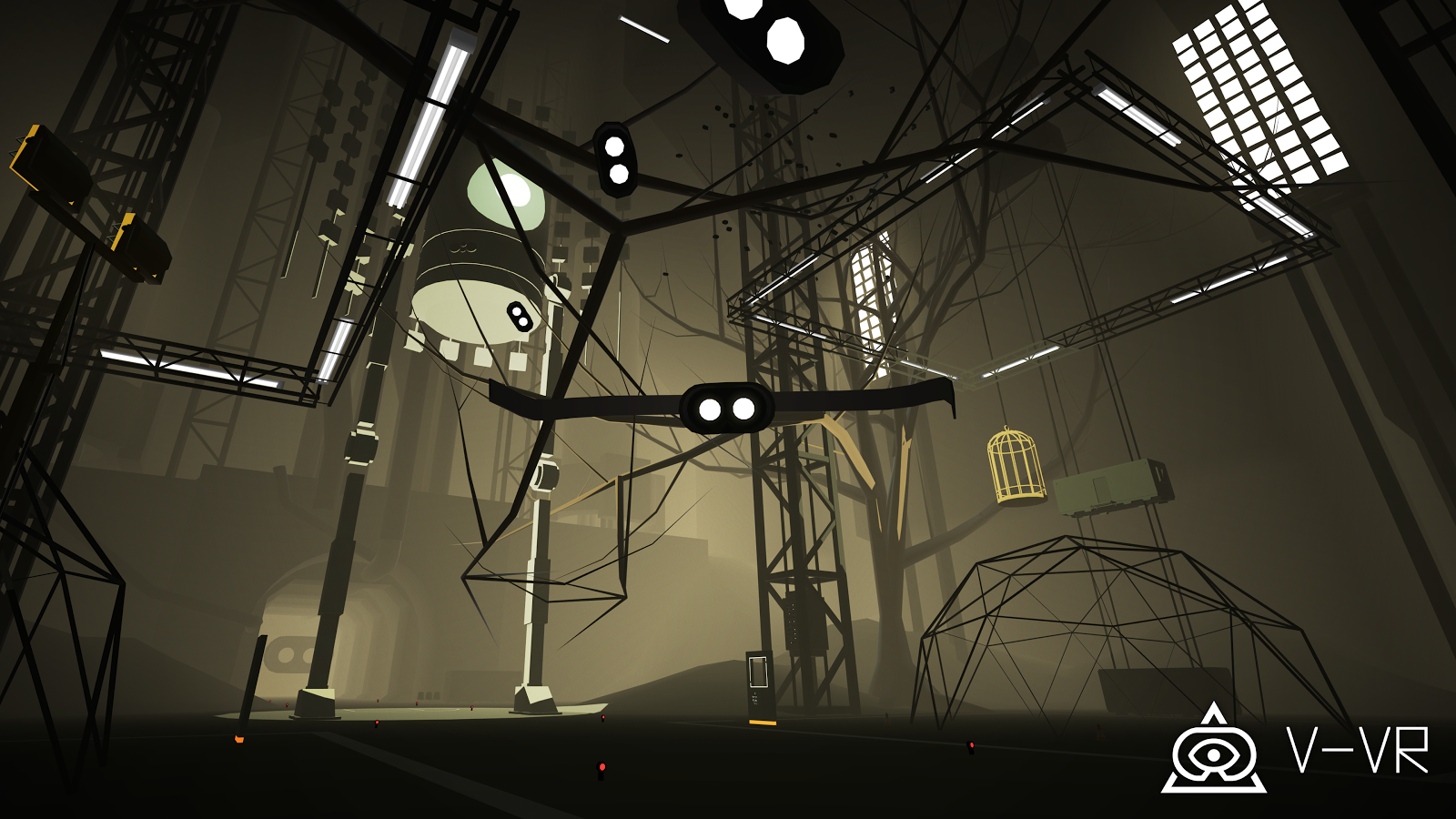
Virtual Virtual Reality for Google Daydream by Tender Claws 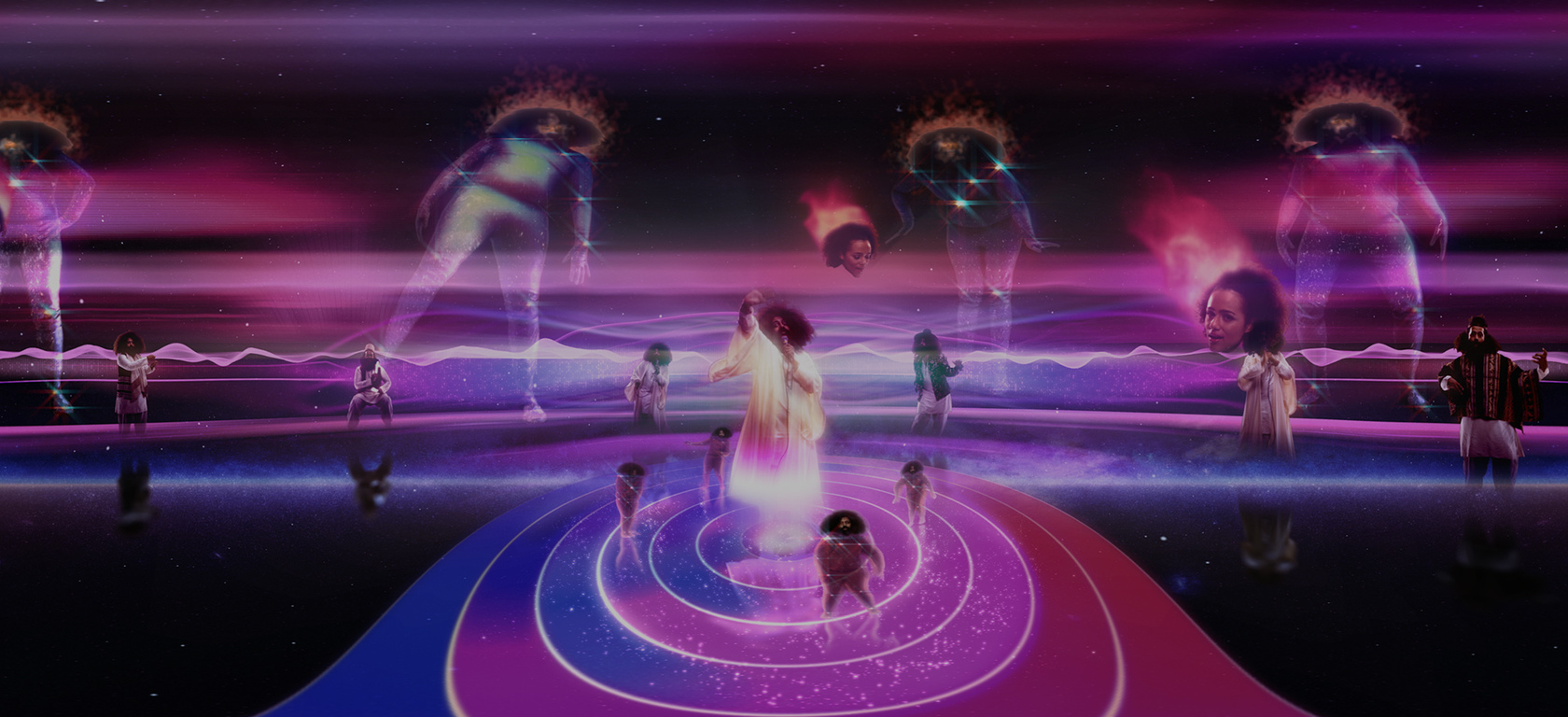
Waves with Weggie Watts, WeVR 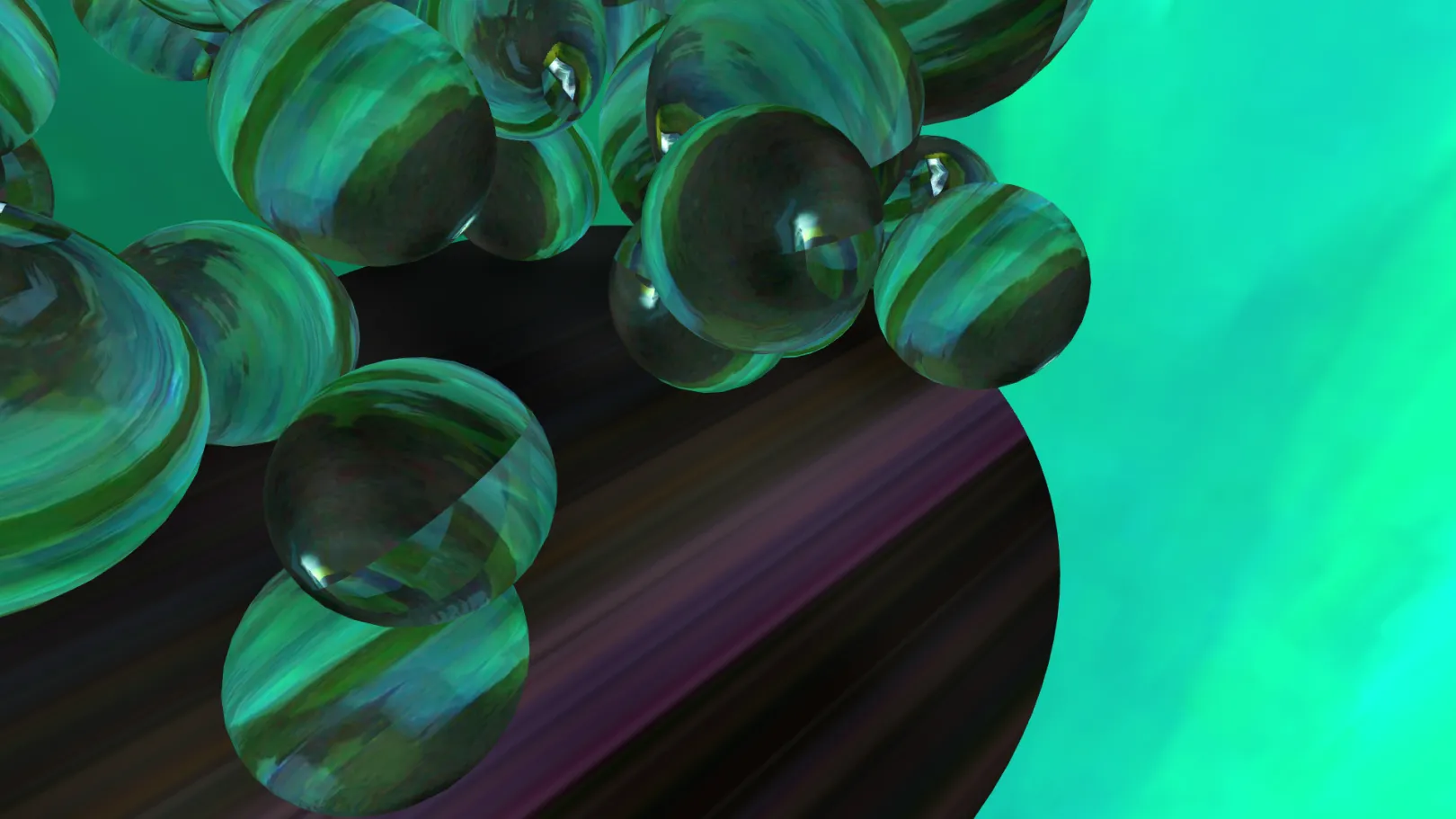
3VR by FLOAT Image for "Hot Dogs, Horseshoes & Hand Grenades by RUST Ltd." not available.
This was a pre-conference panel on June 1, 2017. 3:30–4:30pm (SCI 106)

